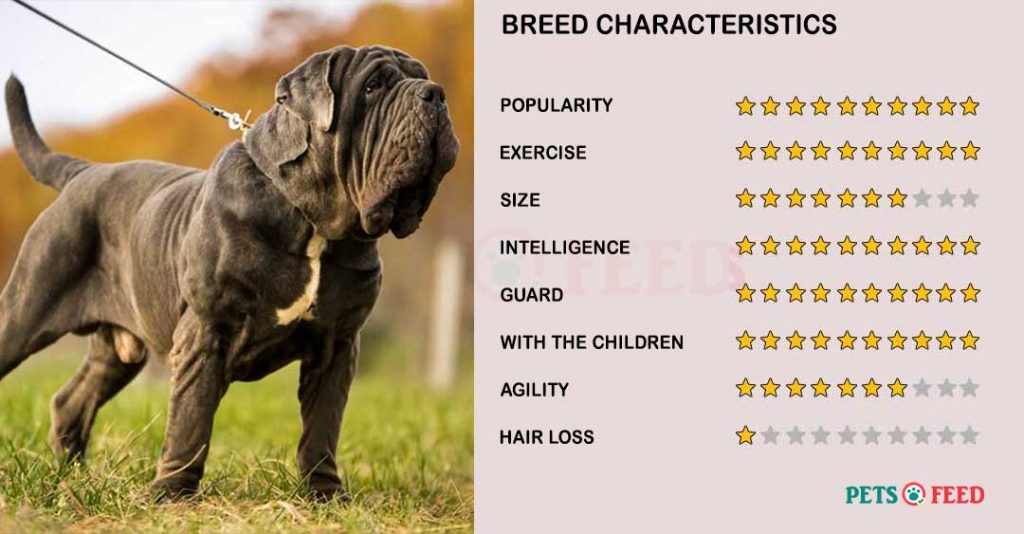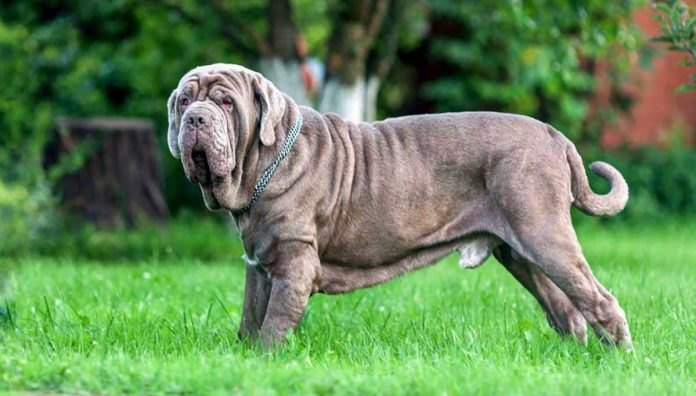The Neapolitan Mastiff or Neapolitano Mastino is a powerful dog that since ancient times gained fame as an invincible, fearless warrior who fought in the arenas of Ancient Rome. He emerged victorious from fights with wild animals. Now such a dog still has tremendous strength, but it cannot be called uncontrollable and overly aggressive.
This dog has a strong character, nerves of steel. He is friendly and loyal to his family members. A more reliable and adequate watchdog cannot be found. A huge dog by its very appearance and grin of large fangs will scare away unwanted visitors.

Photos Neapolitan Mastiff
[foogallery id=”44191″]
Physical characteristics
The Neapolitan Mastiff is a dog of gigantic size and majestic appearance. He is strong and muscular. The length of his body slightly exceeds the height. The size of an adult male is 65 to 75 cm, its weight from 60 to 70 kg, the females’ parameters are slightly lower (weight 50 – 60 kg and 60 – 68 cm).
The short and thick coat has several colors and shades (black, blue, gray, brown, striped). The skin hangs fairly cowardly on the body and the head, although this characteristic should not be excessively pronounced.

Distinctive features
- Head: the skull is wide and flat. The head is short, wide and massive. The muzzle is square, short. The front transition line at the muzzle is clearly represented. There are characteristic skin folds on the head and the muzzle.
- Jaws: The jaws are powerful with thick and fleshy lips. The teeth are large, strong, white as snow in a complete complex. “Scissors” bite.
- Ears: the ears are small, triangular, flat and tied high. Uncoupted ears hang along the cheeks. Moored have the shape of an equilateral and erect triangle.
- Eyes: The eyes are round and medium in size. The color of the iris is dark.
- Frame: the body is elongated, wide, powerful, of slightly rough athletic build. The neck is heavy and massive with a large Fourchu Fanon and a strong and wide tourniquet. The back is spacious and solid. The rump is powerful with a slight slope. The chest is wide, strong, deep and very voluminous. The ribs are significantly convex. The abdomen has returned.
- Members: legs of medium length, muscular, massive. The legs are large, oval with tightly tablet toes.
- Pelage: the coat is short and smooth, fairly dense, while the females are soft and silky, while the males are coarser and harder. Grisish, bridging color, black, Isabelle, blue, mahogany. The presence of small white marks on certain parts of the body is authorized.
Character and behavior
The Neapolitan Mastiff is a calm, balanced and noble dog, sometimes susceptible and vulnerable. Has a good memory and intellectual capacities.
By nature – silent, only bothers in exceptional cases. In the family circle, he is friendly, obedient and affectionate, always happy to communicate.
He treats foreigners with a certain melancholy indifference. However, he instantly turns into angry monster as soon as he feels a threat to his beloved master.
The aggression only manifests itself in the Neapolitan Mastiff rightly. He spends most of his time observing others. For this reason, he was nicknamed “the philosopher”.
Strongly attached to his master, behaves with him as a small child and is faithful to the end of his life. Even with a short separation, he begins to languish with him.
With children
The Neapolitan Mastiff is gifted with children, but given its clumsiness and size, it is better not to leave young children alone.
With other animals
He s indifferent to pets, but can be aggressive towards dogs.
Health
Neapolitan Mastiffs often have the following health problems:
- Demodecosis – affects the skin and internal organs, the pathogens are ticks.
- Joint dysplasia – accompanied by severe pain, lameness and immobility.
- Pyoderma – purulent skin lesions.
- Cardiomyopathy is a disease of the heart muscle and is more common in males.
- Hypothyroidism is a dysfunction of the thyroid gland.
- Entropy is an incorrect position of the eyelid, it is eliminated by surgery.
- Progressive retinal atrophy – If untreated, it can lead to loss of vision.
- Difficult puppy birth – often difficulties arise during childbirth, as a result, you have to resort to cesarean section.
You can avoid many diseases if you vaccinate on time, treat the dog from parasites and show it to a veterinarian for preventive examinations.
Life expectancy
On average the Neapolitan Mastiff can live 9-10 years.
Care
The Neapolitan Mastiff must be brushed each week and must be bathed at least once a month. The shampoo must be chosen so that the skin folds do not dry out. In fact, the folds are a full headache, because they are the source of various diseases and must be maintained clean by rubbing them throughout the day.
The drool is another “good bonus” which you have to face. The eyes must be cleaned daily and keep in mind that skin sagging around the eyes contributes to the accumulation of dust in them. The ears are cleaned several times a week, the claws are cut 3 times a month.
Exercise
An adult Neapolitan Mastin will need approximately one hour of daily exercise, but puppies of this breed should not be unduly stressed during the growth phase to avoid sprains.
Fun facts
- The Neapolitan Mastiff is one of the oldest breeds in the world.
- Alexander the Great’s favorite dog breed was the Neapolitan Mastiff.
- The Neapolitan Mastiff is a clumsy dog with navigation problems.
- The heaviest dog on earth is the Neapolitan Mastiff with a weight of 128 kg.
History of the breed
The Neapolitan Mastiff is a dog that has been guarding its owner and his property since ancient times. The homeland of this breed is Italy. It is believed that the appearance of the first Neapolitan Mastiff dogs occurred in the south of the Apennine Peninsula.
The ancestors of modern Neapolitan Mastiff dogs took part in the enclosure of wild animals and fought in the arenas of Ancient Rome with their relatives or with predators. In most cases, the fight ended with a victory for the molossus.
It cannot be said that the this dog was kept only in the houses of the ancient Roman nobility, although it is worth noting that such pets were a fashionable addition to any rich man. Mastiffs devotedly served ordinary people (watchmen, peasants, shopkeepers). The task of the huge dogs was to protect property, scare off thieves and robbers.
Breeding a Neapolitan Mastiff was not targeted. If the rich people at least somehow watched the purebredity of their molossians, then ordinary people paid attention only to working qualities, to the height, weight of the guard dogs.
The Second World War practically wiped out the purebred Neapolitan Mastiff dogs. When fascism was defeated, it became possible to restore the numbers of these giants. This is exactly what Pietro Scanziani, a connoisseur of the Neapolitans, did in 1946.
He collected 8 representatives of the breed with characteristic features of the exterior. As a result of breeding work in 1949, an exemplary male was bred, which became an example for the approval of the Neapolitan Mastiff breed standard.
Modern Neapolitan Mastiff dogs, instead of battles in arenas, take part in exhibitions. Their strength and intelligence have found application in the police, guard service. Mastiffs have established themselves as bodyguards and guards.


